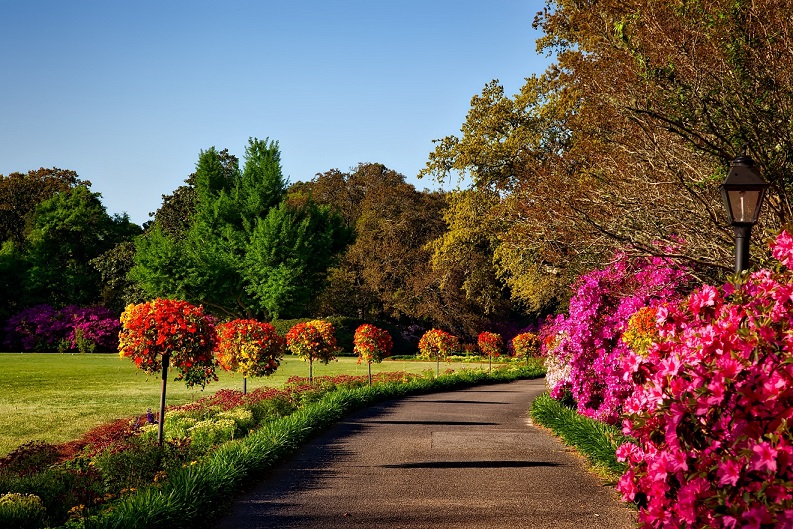Creating a vibrant and low-maintenance landscape is a goal for many homeowners. One effective way to achieve this is by incorporating native plants and flowers into your outdoor space. Native plants are naturally adapted to the local climate, soil conditions, and wildlife, making them resilient and well-suited to thrive in their native environment. By utilizing native species, you can enjoy a beautiful and sustainable landscape that requires less water, fertilizer, and maintenance. In this article, we will explore the benefits of incorporating native plants and flowers and provide tips for creating a vibrant and low-maintenance landscape.
Benefits of Native Plants and Flowers:
- Adaptability to Local Climate: Native plants are naturally adapted to the local climate and weather conditions. They have evolved over time to withstand the specific temperature ranges, rainfall patterns, and seasonal variations of their native region. As a result, they require less water, fertilizer, and maintenance compared to non-native plants.
- Water Conservation: Native plants are typically drought-tolerant and can thrive with minimal watering once established. Their deep root systems allow them to access water sources deep within the soil, reducing the need for frequent irrigation. By incorporating native species, you can conserve water and reduce your overall water usage.
- Reduced Maintenance: Native plants are well-adapted to the local ecosystem and require less maintenance compared to non-native species. They are generally more disease-resistant and less prone to pest infestations, reducing the need for chemical treatments. Native plants also tend to have slower growth rates, minimizing the need for frequent pruning or trimming.
- Wildlife Habitat: Native plants provide essential food sources and habitats for local wildlife, including birds, butterflies, bees, and other beneficial insects. By incorporating native species into your landscape, you can create a biodiverse environment that supports and attracts a variety of wildlife species.
- Soil Health and Erosion Control: Native plants have deep root systems that help improve soil structure, prevent erosion, and reduce stormwater runoff. Their extensive root networks bind the soil, reducing soil erosion and promoting healthy soil composition. This, in turn, improves water infiltration and reduces the risk of flooding.
Tips for Incorporating Native Plants and Flowers:
- Research Native Species: Before selecting plants and flowers, research the native species that are suitable for your specific region and climate. Consult with local nurseries, botanical gardens, or horticultural experts to identify native plants that thrive in your area. Consider factors such as sun exposure, soil type, moisture requirements, and hardiness zones.
- Create a Planting Plan: Develop a planting plan that incorporates a variety of native plants and flowers. Consider their blooming periods, heights, and colors to ensure a continuous display of vibrant and attractive blooms throughout the growing season. Group plants with similar water and light requirements together for efficient watering and maintenance.
- Start with Native Trees and Shrubs: Native trees and shrubs provide a solid foundation for your landscape. They offer shade, privacy, and visual interest while attracting birds and wildlife. Consider incorporating native trees such as oak, maple, or pine, and shrubs like beautyberry, inkberry, or serviceberry.
- Add Native Perennials and Grasses: Perennials and grasses are excellent additions to any landscape, providing texture, color, and seasonal interest. Choose native varieties that are adapted to your region. Some popular native perennials include coneflowers, black-eyed Susans, milkweed, asters, and coreopsis. Native grasses like switchgrass, little bluestem, and muhly grass can add beauty and provide habitat for birds and insects.
- Incorporate Native Groundcovers: Native groundcovers serve multiple purposes, including weed suppression, erosion control, and adding visual interest to areas such as slopes or between stepping stones. Consider native groundcovers like creeping phlox, Virginia creeper, or woodland sedges.
- Design for Diversity: Aim for diversity in your planting design by incorporating a mix of different native species. Diversity enhances the resilience and sustainability of your landscape, reduces the risk of pest and disease outbreaks, and creates a visually appealing and dynamic environment.
- Consider Bloom Times and Color Palette: Select plants with varying bloom times to ensure a continuous display of flowers throughout the growing season. Choose a color palette that complements your home and other landscape elements, creating a cohesive and visually pleasing design.
- Implement Sustainable Landscaping Practices: In addition to incorporating native plants and flowers, practice sustainable landscaping techniques to enhance the overall health and vitality of your landscape. Use organic mulch to conserve soil moisture, suppress weeds, and improve soil health. Implement efficient irrigation methods like drip irrigation or rainwater harvesting systems. Minimize or eliminate the use of chemical pesticides and fertilizers, opting for organic alternatives.
- Monitor and Maintain: While native plants generally require less maintenance, they still benefit from regular monitoring and care. Remove weeds, deadhead spent flowers, and monitor for any signs of pests or diseases. Adjust irrigation as needed, and prune or trim plants when necessary to maintain their shape and health.
- Learn from Local Resources: Take advantage of local resources such as native plant societies, conservation organizations, or university extension offices. They often provide educational materials, workshops, or plant sales focused on native species. Participate in native plant sales or swaps to obtain a variety of native plants suited to your region.
Incorporating native plants and flowers into your landscape offers numerous benefits, including reduced maintenance, water conservation, support for wildlife, and overall sustainability. By selecting native species adapted to your specific region and incorporating them into a well-planned design, you can create a vibrant and low-maintenance landscape that thrives in harmony with the local ecosystem. Take the time to research native species, develop a planting plan, and implement sustainable practices to enjoy the beauty and benefits of a native plant-filled landscape.
